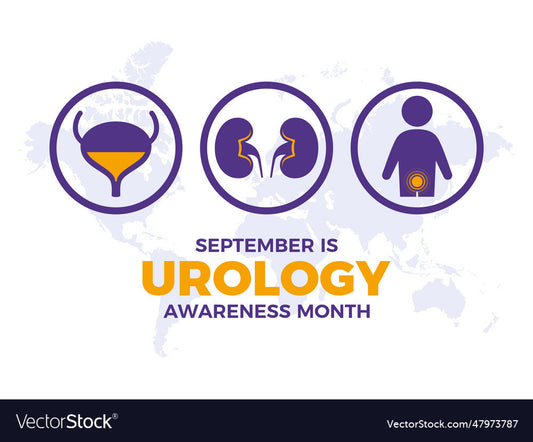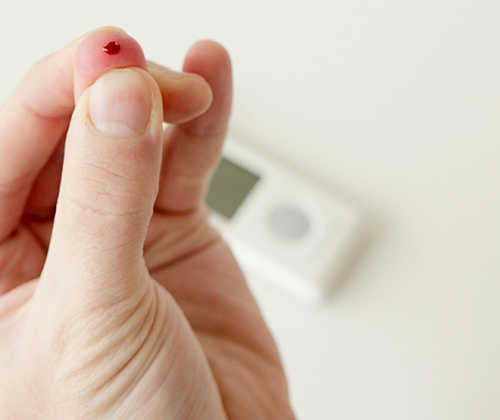What Is Prostate Cancer? A Comprehensive Guide
Find out about the risk factors and symptoms of prostate cancer and when to get tested
Prostate cancer is the second most common cause of cancer deaths in men in the UK with more than 47,000 men diagnosed every year — that’s around 130 every day.
Men over 50 are more likely to develop prostate cancer, and the risk increases with age. Between 70 and 74 is the most common age at which men are diagnosed. However, the number of men aged 40 to 59 diagnosed with prostate cancer has increased six-fold in recent years.
At present, there is no national NHS screening programme for prostate cancer. Most men with early prostate cancer won’t experience any signs or symptoms either, so it's important to understand your risk and know what the warning signs are.
This guide looks at what prostate cancer is, the risk factors, symptoms of prostate cancer, how it’s diagnosed, treatments, and more.
What is prostate cancer?
Prostate cancer is a type of cancer that affects the prostate gland. The prostate is about the size of a walnut and is located below the bladder and in front of the rectum. The primary function of the prostate is to produce the fluid that nourishes and transports sperm.
Prostate cancer can vary in severity. The earlier prostate cancer is diagnosed, the more effectively it can be treated, increasing your chance of survival.
A lot of the time, prostate cancer will grow slowly and will only affect the prostate, not causing serious harm. In these cases, cancer may only need minimal management or even no treatment at all.
However, if the cancer is aggressive, it can grow more quickly and spread into any other areas of the body (commonly the bones and lymph nodes) and is more difficult to treat successfully.
What causes prostate cancer?
It isn’t clear exactly what causes prostate cancer. What is known, however, is that prostate cancer begins when the DNA of the cells in the prostate changes.
These changes create abnormal cells which grow and divide more rapidly than normal cells. When abnormal cells accumulate, they form a cancerous tumour that grows and invades nearby tissue. Over time, abnormal cells can spread to other parts of the body.
Although what causes this to happen is still unknown, several prostate cancer risk factors have been identified which may increase the chances of developing the disease, including:
Age
Age is by far the most significant risk factor. The highest incidence of prostate cancer occurs in men aged 70 and over.
Ethnicity
Black African or African-Caribbean men are more likely to get prostate cancer than other men. The reason for this is unknown, although it might be linked to genetics. According to published research, the lifetime risk of being diagnosed with prostate cancer is approximately 1 in 8 for White men, 1 in 4 for Black men and 1 in 13 for Asian men.
Family history
There are hereditary links with prostate cancer. The risks are higher for men with direct relatives such as fathers and brothers as well as second-degree relatives (uncles, nephews, grandfathers, half-brothers etc.) who have also suffered with the illness.
The hereditary association isn’t confined to male relatives. Men whose mothers have had breast cancer are also at a higher risk of developing prostate cancer.
Genetic factors
A mutation in the BRCA2 gene (also associated with breast cancer) is known to increase the risk of prostate cancer in men who have the mutation.
Obesity
People who are obese (have a BMI above 30) may be at higher risk of developing prostate cancer compared to those who are of a healthy weight. Obese people are also more likely to experience more aggressive forms of prostate cancer and are more likely to have it return after treatment.
Prostate cancer symptoms
In its early stages, prostate cancer may cause no signs or symptoms. The symptoms of an enlarged prostate are very similar to prostate cancer symptoms which is why it is necessary to be aware and vigilant.
Prostate cancer symptoms to look out for include:
- Needing to rush to the toilet to pass urine
- Passing urine more often than usual, especially at night
- Difficulty in passing urine
- Feeling that your bladder has not emptied fully
- Blood in urine or blood in semen
- A weak flow when urinating
- Dribbling urine after finishing urinating
- Discomfort or pain when sitting
If prostate cancer spreads to other parts of the body, it can cause other symptoms, including:
- Bone or back pain
- Loss of appetite
- Unexplained weight loss
- Problems getting or keeping an erection
- Testicular pain
- A change in bowel habits
- Swelling or fluid build-up in your legs or feet
- Fatigue
These symptoms can all be caused by other health problems too. If you’re experiencing any of the symptoms listed above, it’s important to talk to your doctor, so they can find out what’s causing these issues and get you the right treatment.
To learn more about prostate cancer symptoms, visit our blog post on ‘What are the 5 warning signs of prostate cancer?’.

How is prostate cancer diagnosed?
Prostate cancer is much more likely to be treated successfully when diagnosed in the earlier stages. If you’re over 40 years old and are experiencing any symptoms of prostate cancer, it’s important to have a screening and seek a diagnosis.
Initial tests that may be done to rule out and look for signs of prostate cancer are:
A blood test (PSA testing)
A blood test is used to check levels of prostate-specific antigen (PSA) in the blood. This is called PSA testing and can be done via a traditional blood draw from the arm, or via finger-prick testing.
Urine analysis
With a sample of urine, labs and doctors can check for signs of infection that may be the cause of symptoms.
Digital examination
A digital rectal examination is where a doctor inserts a gloved finger into the rectum to check for any abnormalities in the texture, shape or size of the prostate. This may feel uncomfortable but it is over quickly and you shouldn’t feel any pain.
The results of these initial tests combined with personal risk factors can indicate how likely prostate cancer is. If the risk is found to be high, additional tests can include:
MRI scan
Magnetic resonance imaging (MRI) is used to produce a detailed image of the prostate to help doctors decide if a biopsy is required and help plan any treatment.
Ultrasound
A small ultrasound probe is inserted into the rectum to create a picture of the prostate gland.
Biopsy
A biopsy is where a small sample of prostate tissue is collected and analysed to determine whether there are any cancer cells present.
Prostate cancer stages
As well as helping to make a diagnosis of prostate cancer, the tests and scans listed above also allow doctors to determine the stage and grade of the cancer.
The stage of prostate cancer tells you the size of the cancer and indicates if it has spread to other areas of the body.
Prostate cancer stages:
- Stage 1 – the cancer is in only half of one side of the prostate or less
- Stage 2 – the cancer is in more than half of one side of the prostate
- Stage 3 – the cancer has broken through the covering of the prostate gland and may have spread into the tubes that carry semen
- Stage 4 – either the cancer has spread into nearby body organs, has spread to nearby lymph nodes or has spread to other parts of the body outside of the pelvis
The grade is how the cancer cells look and behave compared to normal cells, suggesting how quickly the cancer may grow.
Prostate cancer cell grade grouping:
- Grade group 1 – the cancer cells look similar to normal prostate cells. The cancer is likely to grow very slowly, if at all
- Grade group 2 – the cancer cells look mostly similar to normal prostate cells so are likely to grow slowly
- Grade group 3 – the cancer cells look less like normal prostate cells and the cancer is likely to grow at a moderate rate
- Grade group 4 – the cancer cells look abnormal so the cancer may grow quickly or at a moderate rate
- Grade group 5 – the cancer cells appear very abnormal meaning the cancer is likely to grow quickly
If you have any questions about the stage and grade of your cancer, your doctor will be able to give you further information.
Prostate cancer treatment
Prostate cancer treatment all depends on individual circumstances and how advanced the cancer is.
Early-stage, low-grade prostate cancer often doesn’t need treatment straight away and may not even need treatment at all.
If treatment for prostate cancer is needed, a combination of several treatments may be used. Treatment options for prostate cancer include:
Watchful waiting or active surveillance
Your doctor might use active surveillance or watchful waiting to monitor you if you’ve been diagnosed with prostate cancer.
Watchful waiting is often recommended for older men or those with poor health who may not tolerate treatment well. This is when no further testing is done, but any symptoms that develop are treated.
Active surveillance is used to avoid unnecessary treatment when cancers are deemed harmless. This involves monitoring the progression of cancer through regular follow-up tests including blood tests, MRI scans, rectal exams and biopsies.
Surgery
Surgical removal of the prostate gland (radical prostatectomy) is a treatment option for curing cancer that is either confined to the prostate or hasn’t spread very far.
Radiotherapy
Radiotherapy can be used to kill cancerous cells in cases where the cancer has not spread beyond the prostate or has not spread very far. It may also be used to relieve symptoms and slow the progression of prostate cancer if it has spread to other parts of the body.
Ablative therapy
Ablative therapies destroy prostate tissue with cold or heat. Cryoablation or cryotherapy uses a cold gas to freeze the prostate tissue, killing the cancer cells.
High-intensity focused ultrasound (HIFU) treatment uses ultrasound waves to kill cancer cells by heating them to a high temperature.
These therapies can be used to treat cancer that is confined to the prostate.
Hormone therapy
Hormone therapy alone cannot cure prostate cancer but can help slow down its progression, relieve symptoms and reduce the chances of cancerous cells returning.
Hormone therapy options include medications to stop testosterone production or stop testosterone from reaching cancer cells, or surgical removal of the testicles to reduce testosterone levels.
Chemotherapy
Chemotherapy treatment is often used in cases where the cancer has spread from the prostate to other parts of the body. Chemotherapy doesn’t cure prostate cancer but works to destroy cancer cells and keep growth under control to prolong life.
Immunotherapy
Immunotherapy drugs help your body’s natural immune system identify and attack cancer cells. This option is often used to treat advanced prostate cancers that no longer respond to hormone therapy.
Targeted drug therapy
Targeted drug therapy blocks abnormalities in cells with the aim of killing them. This type of treatment may be helpful in cases of advanced or recurrent prostate cancer where hormone therapy isn’t effective.
How to reduce the risk of prostate cancer
While there are no lifestyle factors associated with increased prostate cancer risk, some things can reduce the risk of cancer developing, such as:
- Eating a healthy, balanced diet: Aim to eat a variety of fruits, vegetables and whole grains every day and limit processed foods. Cut back on alcohol, or stop drinking alcohol completely.
- Exercise regularly: Moving your body helps support overall health and also keeps extra weight off. Aim to do at least 150 minutes a week of moderate aerobic activity.
- Stop smoking: Smoking has been linked to many types of cancer. Quitting using tobacco products and avoiding second-hand smoke can help protect your health and reduce the risk of cancer.
- Maintain a healthy weight: Carrying extra weight can increase the risk of developing cancer. Combining healthy eating with regular exercise can help maintain a healthy weight and aid in weight loss.
- Get tested: As the risk of prostate cancer increases with age, it’s recommended that all men over the age of 40 consider regular prostate cancer screening with a PSA blood test.
Why should I get tested?
Prostate cancer is the most common cancer in men, however, it is often symptomless in its early stages.
It’s important to get tested for prostate cancer as survival rates are much higher when it’s diagnosed at an earlier stage, rather than at a later stage. When diagnosed at its earliest stage, almost all people with prostate cancer will survive their disease for five years or more, compared to around 50% of people when the disease is diagnosed at the latest stage.
Prostate cancer survival rates have tripled in the last 40 years in the UK, most likely because of PSA testing.
As well as offering you peace of mind, prostate cancer screening allows you to check for early-stage prostate cancer that may exhibit no symptoms, improving the chances of curing the disease.
How can I get tested?
There is no national NHS screening programme for prostate cancer in the UK. The UK National Screening Committee decided the disadvantages of regularly screening every man over 50 for prostate cancer using the PSA (Prostate Specific Antigen) blood test outweigh the possible advantages. This is due to the risk of overdiagnosis and possible over-treatment of ‘harmless’ prostate cancers that wouldn’t cause a man any problems in his lifetime.
However, you might want to get tested if you are at a higher risk of getting prostate cancer. This includes anyone over the age of 50, men of Black African or African-Caribbean descent, and men with a close family history of prostate cancer.
If you have symptoms of prostate cancer, you should get in touch with your doctor to arrange any investigations.
A PSA test requires careful interpretation as a raised PSA level does not always mean that you have prostate cancer.
If you’d prefer to test at home, Check4Cancer offers a Prostate Cancer Screening Test — a safe, accurate and affordable private prostate cancer test with rapid results.
Order your prostate cancer test kit
Our Prostate Cancer Screening Test is a simple at-home finger-prick PSA blood test and a personalised prostate cancer screening programme. Our team of specialists analyse your PSA test results and risk factors to determine what the next stage is for you. Extended tests could include a physical examination, MRI scan or biopsy.
The Prostate Cancer Screening Test is at-home cancer screening and includes Free and Total PSA for men aged 40 and over.
Check for prostate cancer by ordering a Prostate Cancer Screening Test today.
All articles for prostate

Men’s Health Week: 9-15th June, 2025
Men’s Health Week 2025 carries the powerful theme: “Shoulder-to-Shoulder:Connecting for Health”. This year, the focus is on fostering connection, empathy,...
Read more
Prostate Cancer Awareness Month
Prostate Cancer Awareness Month is a time to highlight the significance of early detection and encourage men to prioritise their...
Read more
Prostate Cancer Screening Update 2024
We should continue with PSA testing, followed by prostate MRI scans for men with raised PSA to determine who required...
Read more
What You Should Know About Urology Awareness Month
The main objective of Urology Awareness Month is to address the stigma surrounding urological health. Early detection of urological diseases...
Read more
Understanding Men’s Health Awareness Month and Its Importance
Held each November in the UK, Men’s Health Awareness Month focuses on increasing awareness and providing information while raising funds...
Read more
The Future of Testing for Prostate Cancer
PSA (Prostate-Specific Antigen) testing remains an important tool in the fight against prostate cancer
Read more
What is a PSA Test and How to Check for Prostate Cancer?
Everything you need to know about PSA tests and how to check for prostate cancer, so you can take charge...
Read more
How Often Should You Check For Prostate Cancer?
An in-depth look at prostate cancer screening, including who should get tested, at what age and how often.
Read more
Five Warning Signs Of Prostate Cancer
The majority of prostate cancer symptoms are also associated with other health problems that affect the bladder and urination, so it’s important...
Read more
Prostate Cancer Awareness Month: What are the symptoms?
Knowing what to look out for and recognising suspicious changes to your body is one of the most important ways...
Read more
Male Cancer Awareness - know the facts and get checked
We take a look at three cancers for which men are more at risk – prostate, bowel and lung –...
Read more
What are the symptoms of prostate cancer?
Prostate cancer is caused when cells in the prostate gland grow abnormally and form lumps called tumours. How do you...
Read more
AXA PPP enhances prostate cancer diagnosis pathway
AXA PPP healthcare has teamed up with screening service, Check4Cancer, to enhance its prostate cancer diagnosis pathway
Read more